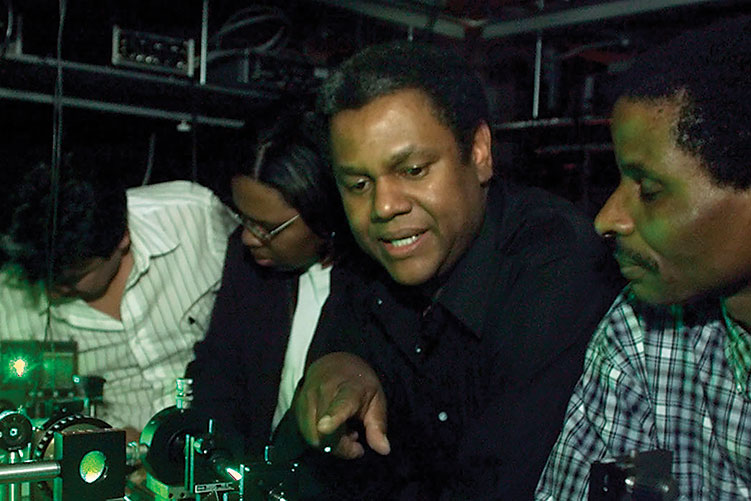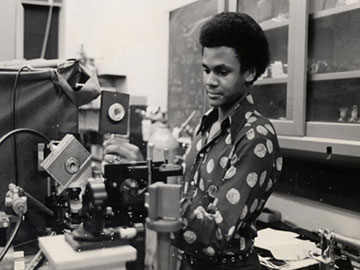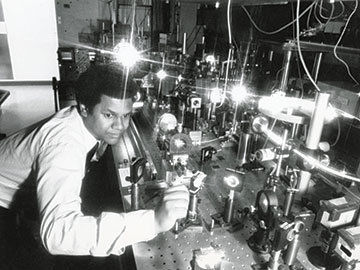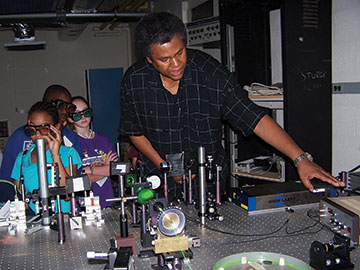
(From left) Hernando Garcia, Elaine Lalanne, Anthony Johnson and Ferdinand Oguama. [Image: Courtesy of A. Johnson]
Editor’s note: In a May 2023 feature article, “Breaking Barriers, Advancing Optics,” Optics & Photonics News profiled six Black scientists in the United States, their pathbreaking work in optics, photonics and related areas, and their perspectives on progress and challenges for underrepresented groups in science. In this special accompanying online “Conversations” series, we offer edited versions of the interviews behind those profiles.
In this installment, OPN chats with Optica Fellow Anthony Johnson, Director of the Center for Advanced Studies in Photonics Research (CASPR) at the University of Maryland, Baltimore County, USA.
Can you talk about what drew you to science and what direction your interests initially took?
Anthony Johnson: I knew very early on that I wanted to do science; I had chemistry sets and did all kinds of strange things with making gun powder and stuff like that. I didn’t know which field of science, but that interest goes back to elementary school.
But in high school, it congealed into physics. I had a very strong physics teacher at Tilden High School in Brooklyn, NY, USA. Unfortunately, I was the only Black student in his class, but he took an interest in me and really made physics interesting. I even went to his alma mater for my undergraduate studies—Polytechnic Institute of Brooklyn, then Polytechnic Institute of New York. I figured I couldn’t go wrong if this was someone I really respected.
And how did you get from there to Bell Labs?
At Polytechnic, I had a physics professor, Donald Scarl, who knew about the summer research program at Bell Labs, which I had never even heard of at that point. I was a junior in physics, and he encouraged me to apply to this program for minorities and women at Bell Labs. So he put me in that direction, and as they say, the rest is history.

Johnson during the AT&T Bell Labs summer research program in 1974. [Image: Courtesy of A. Johnson]
I have a connection that has been so strong with Bell Labs, and I don’t know what would have happened if he hadn’t steered me in that direction. And so I had a fantastic summer at Bell, and that felt kind of like the first time I’d left Brooklyn. It was such a change, even just the surroundings—tree-lined streets without sidewalks, instead of mostly concrete, like I was used to.
And I also had a fantastic mentor in David Auston. He was a member of technical staff at Bell Labs and I ended up working in his group. We were working on lasers, and that’s how I got into optics. That summer was really fruitful;. I learned a lot. And I published a paper. We wrote a paper together, and Auston allowed me to be first author.
You went on to work as a member of the technical staff at Bell Labs for 14 years. Can you tell us about that experience?
The 14 years was after I completed my Ph.D., but before that I spent summers at Bell Labs, as a technician and also working with Auston. I got a Bell Labs fellowship—Bell Labs Cooperative Research Fellowship Program, CRFP—to pursue a Ph.D., and he’d agreed to be my advisor. My university connection was CCNY under the direction of Robert Alfano. So I did all my thesis research at the facility in Murray Hill, NJ, and coursework at CCNY. I had all this interaction with Bell even before those 14 years.
In its heyday, Bell Labs was just about doing high-quality research, publishing in the best journals. And there was funding to support this enterprise to do leading-edge research. And of course, that was AT&T—at that time, it was a monopoly, and it could take a percentage of its profits to support this research laboratory.
And so as I was working toward my Ph.D. and starting do the background reading for my dissertation, I realized that the authors of many of the papers that I was reading were down the hall from me. What a phenomenon, to know that all you have to do is walk down the hall and knock on the door and sit down and talk to them. And scientists love to talk about their work and spread the knowledge. So that was a really interesting experience.
What do you think was the longer-term impact of your time at Bell on your career?
I’m very fortunate, and I got to do quite a few things. And a lot of that was my Bell Labs connection. I really got a good start with my advisor; we just had a good relationship. And so I learned about picosecond phenomena and things like that with him as an undergraduate, and then on through graduate school, I used those techniques.
Then after I finished my Ph.D. I was hired in Holmdel, the other big research lab at Bell Labs, by Auston’s friend and colleague Charles Shank. So I took my ultrafast skills—then it was picosecond, now it’s femtosecond—down to Holmdel, and I had strong collaborations and publications.

Johnson working in his lab at AT&T Bell Laboratories in Holmdel, NJ, in 1986. [Image: Courtesy of A. Johnson]
My budding relations with members of staff in Holmdel led to some impactful work. I got to work with Roger Stolen, who was then “Mr. Fiber Nonlinear Optics,” using ultra-short-pulse propagation in fibers. I also got to work with Alastair Glass, who was very well known in photorefractive materials. We did the first experiments on using photorefractive semiconductors in the infrared, and I had a Nd:YAG laser. So we did the first four-wave mixing experiment in photorefractive semiconductors back in the 1980s.
It sounds like things were going quite well for you in Holmdel. How did your transition from industry to academia come about?
It turned out that in the process of doing my work in ultrafast optics, I’d made a lot of connections in the field, at conferences and so forth. One day I got a call from a colleague, John Federici, at the New Jersey Institute of Technology (NJIT). I assumed he was calling to talk about semiconductor research or something, but he said, “No, I’m actually calling to see if I can get you to apply to be chair the physics department here.” It kind of took me aback.
I had to really think about that, and of course, have extensive discussions with my wife Adrienne about making such a change. Because things were going well at Bell. But I also had the opportunity to work with students in the same summer program I’d attended, and I realized that I really enjoyed that. And so I thought maybe I should take a stab at academia—especially since things were going well at Bell. If you’re going to leave a place, you should leave on a high note. So I applied, and I got the position.
And since Newark is still in New Jersey, I envisioned doing sabbaticals at Bell Labs and that I would still have a strong connection with Bell. But then the surprise was that Bell Labs imploded. And I had this great position at NJIT, and everybody thought I knew that this was coming. No, it was just dumb luck. I got a great offer, and I was smart enough to take it.
While at NJIT, you built an ultrafast-optics lab. It seems like that must have had its own challenges.
Oh, absolutely. We went for NSF support for an optics center and we got the funding. But we couldn’t immediately get the space to actually build the lab and use the funding to buy equipment.
Once we got the funding, of course, the administration didn’t want to give it back—so we got space, and it was really nice space. We were teaching optics across several departments, engineering as well as physics and chemistry. Collaborating with a number of departments, we put together this photonics and ultrafast laboratory at NJIT. In the end it was a really nice enterprise that worked out well.
You’ve been at UMBC since 2003, and you’re the director of the Center for Advanced Studies in Photonics Research (CASPR). Did you have a role in building this center as well?
The idea of building a photonics center was already there when I arrived, but they were looking for someone to be the director—to lead it and help it grow.
I had colleagues at UMBC from back in my days at Bell Labs, two faculty members in the electrical engineering department, Curtis Menyuk and Gary Carter. And periodically they review the departments, so they suggested that I come and be part of the committee reviewing the photonics effort in the EE department. Apparently I made an impression because after that, the vice president for research was interested in my applying to be the director of the center.
So I was recruited to UMBC to run this center, and I have a joint appointment in physics and electrical engineering.
“It was just so touching that they were willing to pick up and move with me to Maryland. I couldn’t have made it without that effort to get my foot in the door and get started—my students made it possible.”
How has that experience been for you, after nearly 20 years?
Twenty years, and many graduate students and undergraduate students. And it has been a quite an experience. I thought when I took the position that I would be able to move to Maryland, but circumstances prevented that at the time. So now I’ve been commuting every weekend from the same house in New Jersey for all these years.
I was really fortunate to have students at NJIT who decided to come with me to Maryland. And one student, Elaine Lalanne, who had just completed a Ph.D. with me in physics in 2003, was really critical in moving my lab and getting a start at UMBC. And it was just so touching that they were willing to pick up and move with me to Maryland. I couldn’t have made it without that effort to get my foot in the door and get started—my students made it possible.
And then in 2006, another Bell Labs alum, Claire Gmachl, contacted me about writing a proposal for an NSF Engineering Research Center. She had moved to Princeton, and she was working on quantum cascade lasers and so forth with Federico Capasso. The center was called MIRTHE—mid-infrared technologies for health and environment.
What went into setting up MIRTHE?
We put together this proposal, and we were amazed that we got it on the first shot. There are a number of universities tied to the center; I was the deputy director, and Claire was the director. It was an ERC, Engineering Research Center, the first one ever at UMBC.
As part of the ERC, we built at UMBC a tunable, femtosecond infrared source. Quantum cascade lasers have their strengths in the mid-IR, so we built a system where we could monitor and look at gain dynamics in quantum cascade lasers. We needed an ultrafast source to look at some of the physics of how these things work because some of processes in the quantum cascade lasers are on a femtosecond timescale. So we could actually do pump–probe experiments and try to understand the gain dynamics.
And then we also did some diagnostic experiments. We gave feedback to the growers, as people could grow these things by molecular beam epitaxy (MBE) or MOCVD (metal-organic chemical vapor deposition)—two different semiconductor growth processes with very different growth rates. And so we were able to give some feedback on the quality of the materials using ultrafast pump-probe techniques. We got a couple of good papers out of that using our tunable femtosecond source. We had the Center for 10 years—it’s five years, and then renewable for five, with a 10-year limit even if you’re setting the world on fire.
You seem to have a recent interest in bio-optics. Are you finding that a particularly exciting area?
Yes. Rather fortuitously, there was a faculty member, Liang Zhu, in the mechanical engineering department at UMBC who was interested in thermal management. She was looking at cancer, and she was using microwaves to try to inhibit the growth of prostate cancer in mice. And she thought maybe we could do this optically, so she reached out to me about using our lasers.
She would inject the mouse with prostate cancer, and then let the cancer grow. Then she would inject gold nanorods near the tumor because she had learned that if you raise the temperature of the tumor by something like 15 to 20 degrees C, the cancer cells begin to die. And it turns out that red light at 800 nm, which is the typical wavelength for titanium doped sapphire laser, will penetrate the skin.
Did she actually bring the mice to your lab?
She did! She came to my lab, and we set up a platform where she could put an anesthetized mouse, and we would send in a red beam and put a thermocouple on it to see if we could measure the temperature rise. The medical protocol forbade any one of us to handle the mouse, which was fine with my students. And we used picosecond pulses, which allowed us to not burn the skin, so that was really important. If you had used a continuous-wave laser, you would have had the chance of possibly damaging the skin and hurting the mouse. Some of my grad students were a little squeamish about bringing a mouse into the lab, but they got the hang of it.
“We set up a platform where [Liang Zhu] could put an anesthetized mouse, and we would send in a red beam and put a thermocouple on it to see if we could measure the temperature rise.”
There were two tumors; one we excited, one was the control. After a couple of weeks, the tumor we excited with the laser was gone—it had shrunk to nothing. The other one just continued to grow. So we published that, and we got funding from NSF to continue a few experiments. But that was really our first foray into bio-optics. And it was a lucky accident—Liang Zhu searched the UMBC webpages and found us (CASPR).
Changing directions a bit, can you tell us about your wealth of experience in diversity and inclusion efforts?
I’ve been involved with diversity efforts with both OSA (now Optica) and APS for many years. I was chair of the APS committee on minorities in physics back in 1992 and 1993, and I was on an OSA committee as well. And we talked about how to improve representation and so forth.
Elsa Garmire was the chair of a “women in optics” group, and they would meet at the Optica annual meeting. I sat in on a few of those, and I asked Elsa if we could join up and expand the group to be women and minorities in optics. She agreed to that and was very welcoming—I’ve always appreciated that. So we started this ad hoc committee, trying to do what we could to attract women and minorities into optics.
I was also part of something called a recruiting advisory committee at Bell. We would look at candidates coming in and make sure that the search committees had women and minority candidates, to try to improve the diversity of the scientific staff.
Has it been a challenge to balance those contributions with your other work?
One of the lessons that I learned at Bell Labs was that, while I had support to do diversity efforts, if you made the mistake of being 100% diversity, you didn’t survive. You must do your research. And so I tried to not only do my hopefully leading-edge research, but also diversity activities. My feeling is that if my research were to completely go away, I would have no credibility to do diversity. So it’s important that you maintain that as well and not lose your research edge.
I learned it was possible to do to do both research and diversity—it was very time consuming, but it was possible. But I had to really work hard to try to have the right mix, so that I could continue to publish strong work, and once I was in academia, to be sure that I had good projects for my graduate students. But I did try to continue to do the diversity activities—I thought they were just too important to let go. Some of the fruits of doing these things is that so many students remember me and some of the advice I gave them over the years, and it’s been quite rewarding.
“I learned it was possible to do to do both research and diversity—it was very time consuming, but it was possible. But I had to really work hard to try to have the right mix.”
Do you think you’re seeing progress in representation in physics?
Still to this day, there are just so few scientists of color attending technical meetings, and that’s taking forever to change. It’s been incremental, and I’d love to see more.
The most recent effort by Optica, though, the Amplify Optics Immersion Program, has been more dramatic. I had the pleasure of hosting a Sunday group at the last FiO, and Optica had invited a number of black scientists from around the world. And I had never seen that many in one spot! We had a couple of panels about diversity, and it was quite rewarding to talk about my experiences. So we’ll see if that continues. That was a good start; trying to change the makeup. I could see the joy on the faces of the students who were there, just talking to each other.
In the past, I would see good numbers of Black and Latino scientists at the National Society of Black Physicists (NSBP) meetings and the National Society of Hispanic Physicists. That was a place where you could meet your colleagues and discuss things, and it was really rewarding, refreshing and rejuvenating to go to those meetings.
But not everyone can do that. Attending meetings is expensive, so you have to make decisions. If you’re a budding physicist and you’ve got a limited amount of travel funds, maybe you would like to go to the NSBP meeting, but in order to push your research forward you might have to go to FiO instead. You might not be able to do both because you don’t have the travel funds. So things are slowly changing.
What factors do you think are important in supporting students from underrepresented communities?
“There were very few Black graduate students—they didn’t see people who looked like them. And then all of a sudden, I was attracting Black and Latino graduate students because they felt that I could provide a nurturing environment.”
One important factor is having a supportive environment and feeling welcome. When I went to NJIT, I was the first Black faculty member and Chair in the physics department. I learned that there were very few Black graduate students—they didn’t see people who looked like them. And then all of a sudden, I was attracting Black and Latino graduate students because they felt that I could provide a nurturing environment. Some of them were deciding whether they wanted to go to grad school or not, and after they approached me, they stayed and went on to get their doctorates.
At one point, I wasn’t even sure that role models were important. But when I got to NJIT, I realized how critical they are. It was important for these students to actually see practicing Black and Latino scientists. I had an experience at an NSBP meeting with a Black student from Appalachian State University. I gave a talk, and he came up to me afterward and said, “I had heard there were Black Ph.D. scientists, but I had never seen one before.” And he said how important it was to him to hear and see me talk.
If you don’t feel that you’re being welcomed, then you’re just not going to thrive. And so it’s really important to have faculty members who are interested, understand the problems these students have and make the graduate experience welcoming.
Myself, I really only had one Black mentor, and that was Shirley Jackson, when I was a graduate student at Bells Labs in Murray Hill. But most of them were white males. But somehow I had a really good relationship with so many of them—I’m sure some of them didn’t even know they were mentors.
It sounds like you had a really influential teachers and role models yourself from a young age. Can you talk about the importance of early science education?

Anthony Johnson with middle school students in a training lab at the University of Maryland, Baltimore County, USA. [Image: Courtesy of A. Johnson]
I had a really interesting experience going into Detroit middle and high schools to talk about lasers many years ago. At the high school, I noticed that the kids’ eyes were beginning to glaze over during my talk. Then as I was leaving, these two young women ran up behind me, and they wanted to know all about lasers and what kinds of things they do. But they were constantly looking over their shoulders—they didn’t want any of their peers to know.
So, at the high school level, I found that the attitude was somewhat anti-intellectual. These young women were excited about what I had to say, but they couldn’t show it.
It was very different when I spoke at a middle school—I had the students in the palm of my hand. There seems to be an age where your views get hardened. I’ll never forget that experience. So the younger you can get some spark of interest, the easier it is for that interest to continue on. Later, it could be much harder to get them interested. When they’re in college, they’ve already made choices.
So if you can get them at the high school or earlier level by bringing in really great speakers that make science appealing, you might catch a few.
